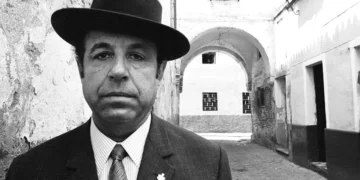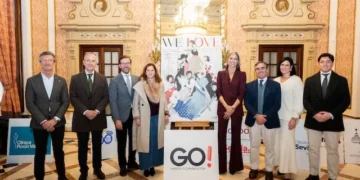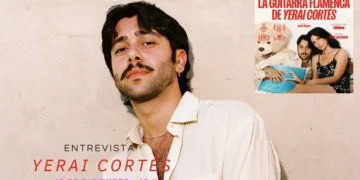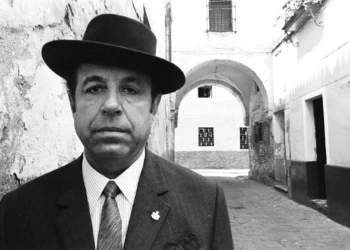|
| Daily coverage BIENAL DE FLAMENCO sponsored by: |
Dance: Ana Moya, Rafaela Carrasco, Manuel Liñán,
Lidia Pousa, Estefanía la Mimbre, Violeta Ruíz, Mayte
Beltrán, Rocío Martín, Mariana Collado, Francis
Núñez, José Antonio Jurado. Narrator: Curro
Albaicín. Cante: Vicente Gelo, Manuel Gago. Guitar: Fernando
de la Rúa, Jesus Torres, José Luis Rodríguez.
Percussion: Raúl Domínguez. Piano: Pablo Suárez.
Cello: José Luis López. Recorded music: Miles Davis,
Carmen Linares, Enrique Morente, José Luis Rodríguez,
Pablo Suárez, Jesús Torres.
Having seen “Caminos de Lorca” in the early
days of its Granada premiére two months ago, its inclusion
in Seville’s Bienal de Flamenco offered a chance to evaluate
the evolution of a daring new work. Despite the absence of dancer
Belén Maya, star of the show in its Granada run, the work
has improved considerably and the Teatro de la Maestranza is a far
more appropriate venue than the historic but austere patio of the
Carlos V palace where the show was presented for a month.
An original, entertaining and coherent
work
The members of the group have developed an artistic rapport, the
whole thing has acquired a certain warmth, and if you make an effort,
you can even read between lines to detect director Pepa Gamboa’s
contrived goal of producing “a surreal dream about Lorca’s
spiritual children” and innocent victims the world over. That
ambitious suspicious-sounding goal goes down a bit easier thanks
to a generous dose of humor provided for the most part by Curro
Albayzín, alumnus of the Sacromonte caves, who plays himself,
sort of. Singer, dancer, you-name-it…he narrates the action
with verse and chit-chat with the presence and carriage of a perverse
cabaret showman from the nineteen-thirties. It’s a bit of
genius to have included his character, the best thing in the show,
and something that seemed to escape the classy theater-goers of
the Maestranza.
Lorca’s famous arrangements of Spanish folksongs alternate
with updated traditional flamenco. Given the presence of a competent
team of singers and musicians, the inclusion of canned voices and
music continues to be annoying, just as the buzz of bombers overhead
that sounds between numbers is at odds with the historic reality
of Granada’s role in the Spanish civil war where the action
is set.
The rich music of María la Canastera for the cachucha, the
mosca and alboreá, all Granada specialities, continues to
go uncredited on the program, so these words stand for the record.
This music is important since it’s not as folkloric as something
like Anda Jaleo, nor as flamenco and sophisticated as a soleá,
although it incorporates elements of both and personifies the essence
of Granada.
The group choreographies lack imagination and look like dance classes,
but the solo dances are original and inspired. It would be hard
to think of a less likely-looking flamenco dancer than Manuel Liñán
who could pass for an adolescent Dennis the Menace, but he’s
a first-class dancer and the novel figures he draws with his body
are always flamenco, no matter how avant-garde. His co-star is something
else – ice lady Rafaela Carrasco. Her product is first modern
dance, with flamenco a distant second, and despite the obvious quality
of her dancing, her projection is annoyingly cold and robotic.
It sounds like a lot of nit-picking perhaps, it goes along with
the job, but overall, this is an original, entertaining and coherent
work.
Text: Estela
Zatania
|
|
Related products:
|
|
|























